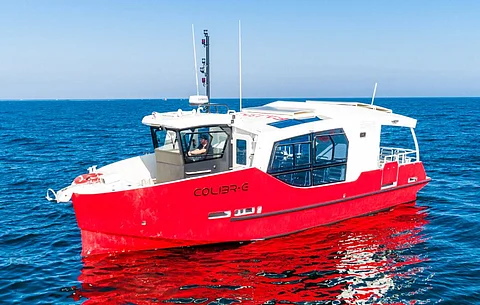

ODC Marine recently handed over a new hybrid-powered tour vessel to KapMer, an operator that provides sightseeing and whale-watching excursions off the southern coast of France.
Designed by French naval architect Eric Jean, Colibr-e was acquired in fulfilment of KapMer owner Yoan Salomon's aim of providing tour services while minimising environmental impact.
"The owner was looking for the lowest environmental impact possible while ensuring the best experience for passengers," ODC Marine told Baird Maritime. "Specifically, he had wanted sailings at 5.5 knots for up to two hours and an ideal duration of three hours on electric propulsion."
The builder added that the new vessel also needed to be manoeuvrable enough to deal with strong winds. The propulsion arrangement therefore includes bow and stern thrusters on top of two main counter-rotating propellers.
"Finally, the owner was also looking for a good-looking boat, with modern and stylish lines and a prominent colour," added ODC Marine.
Measuring 12.8 by 4.2 metres and displacing 18 tonnes, Colibr-e utilises an existing Eric Jean boat design but with a modified superstructure to offer greater volume and comfort for passengers. New features include integrated side and central windows to provide excellent visibility and to allow as much natural light as possible into the interior spaces. The interiors also boast a toilet and design elements that guarantee improved access for passengers with reduced mobility.
"The electric propulsion has also been upgraded with the latest generation of lithium iron phosphate batteries offering 60 per cent more capacity at similar weight and volume," ODC Marine said. "The new setup ensures three hours of sailing at 5.5 knots even at full load."
The hybrid parallel propulsion arrangement consists of two Cummins QSB6.7 diesel engines that each produce 260 kW at 2,800 rpm, two ZF 301A gearboxes, two ZF four-bladed propellers, and two brushless 20kW electric motors. The system is compliant to Bureau Veritas rules and delivers a top speed of 20 knots and a cruising speed of 16 knots.
The batteries also offer the added benefit of reduced charging times due to the increase in total output to 63 kWh. Charging of the batteries to full capacity can be completed in as little as four hours.
The vessel is built entirely from aluminium and environmental impact is reduced through the use of water-based paint for the exteriors. LED lights are fitted all throughout to minimise energy consumption while sailings are made more comfortable with the aid of an optimised noise and vibration control system.
"The challenge lay mainly in ensuring comfort on a somewhat bigger vessel compared to the original 12-metre-long design," ODC told Baird Maritime. "We thus fine-tuned the design of the shaft brackets to optimise water flow and reduce further vibration and noise over the propellers."
The vessel's electronics suite includes a Simrad radar, an Airmar depth sounder, and a Marinelec Technologies monitoring system developed jointly with ODC Marine. This system collates all information related to safety, electronics, propulsion, batteries, and fuel tanks to provide the crew with real-time updates on the vessel's condition via a touchscreen in the wheelhouse.
"This monitoring system aims to improve safety, reduce fuel consumption, and simplify maintenance," said ODC Marine.
Colibr-e has been conducting operational sailings in the coastal waters of Argelès-sur-Mer, Collioure, Port-Vendres, and Paulilles since the summer of 2022.
| Colibr-e | |
| SPECIFICATIONS | |
| Type of vessel: | Sightseeing vessel |
| Port of registry: | Port-Vendres, France |
| Flag: | France |
| Owner: | KapMer, France |
| Designer: | Eric Jean, France |
| Builder: | ODC Marine, China |
| Hull construction material: | Aluminium |
| Superstructure construction material: | Aluminium |
| Deck construction material: | Aluminium |
| Length overall: | 12.8 metres |
| Beam: | 4.2 metres |
| Displacement: | 18 tonnes |
| Net tonnage: | 14 |
| Main engines: | 2 x Cummins QSB6.7, each 260 kW at 2,800 rpm |
| Gearboxes: | 2 x ZF 301A |
| Propulsion: | 2 x 20 kW; 2 x ZF propellers |
| Side thrusters: | 2 x Quick |
| Steering system: | Lecomble and Schmitt electro-hydraulic |
| Maximum speed: | 20 knots |
| Cruising speed: | 16 knots |
| Batteries: | Optima lithium iron phosphate, 63 kWh |
| Radar: | Simrad Halo 20 |
| Depth sounder: | Airmar SS60 |
| GPS: | Simrad NSS9 evo3 |
| Audio/video system: | Fusion |
| Monitoring system: | Marinelec Technologies |
| Capstan: | Quick |
| Anchor: | Rocna |
| Interior lighting: | LED |
| Firefighting equipment: | Novec 1230 |
| Liferaft: | Survitec |
| Type of fuel: | Diesel |
| Fuel capacity: | 1,000 litres |
| Fuel consumption: | 90 litres per hour at 80 per cent load and 16 knots |
| Freshwater capacity: | 100 litres |
| Sewage/blackwater capacity: | 100 litres |
| Accommodation: | Toilet |
| Crew: | 2 |
| Passengers: | 48 |
| Operational area: | Southern France |
